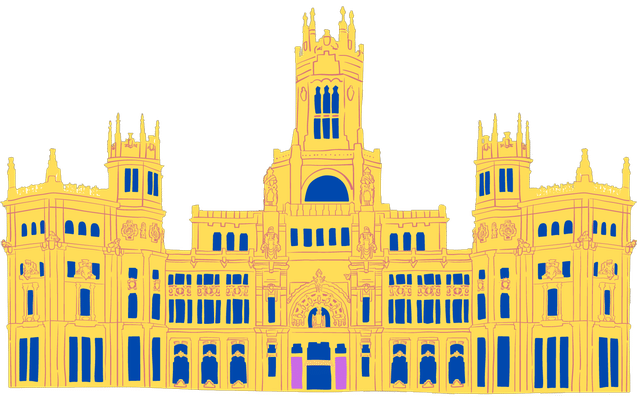Puerta De Alcala Overview
Architecture of Puerta de Alcala madrid
It showcases a remarkable neoclassical architectural style. Standing at the Plaza de la Independencia, this grand monument is composed of solid stone blocks and intricate carvings. Its symmetrical design features five central arches and two smaller side arches, all supported by Doric columns.
Its presence is enhanced by its massive size, reaching a height of over 19 meters. The central arch is flanked by two towers, each crowned with a dome and topped by statues. The gate's façade exhibits a harmonious balance of geometric shapes, with rectangular and circular motifs repeated throughout.
Aesthetically pleasing and historically significant, it has become an emblem of Madrid's architectural heritage. Its neoclassical design embodies the elegance and grandeur of the 18th century, making it a captivating sight for visitors and a point of pride for the locals.
Why Puerta De Alcala is Famous?
Its historical significance as one of Madrid's oldest and most recognizable landmarks makes it a symbol of the city's rich heritage. Built-in the late 18th century, it served as a grand entrance to the city and played a role in welcoming royalty and important visitors.
Puerta de Alcala’s architectural beauty and design have captivated people throughout the years. Its neoclassical style, featuring monumental arches and columns adorned with ornate details, showcases the skilled craftsmanship of its creators. The monument's harmonious proportions and elegant presence have made it a favorite subject for artists, photographers, and filmmakers.
It’s prominent location adds to its fame. Situated in the heart of Madrid, it stands at the junction of two major roads, and its proximity to other renowned landmarks like Retiro Park and the Gran Via makes it a popular tourist attraction. The monument's role as a meeting point, backdrop for cultural events, and symbol of Madrid's identity have cemented its place in the hearts and minds of both locals and visitors alike.
Know Before You Go
Location: It is situated in the heart of Madrid, Spain, at a significant intersection known as Plaza de la Independencia.
Opening Hours: Open 24 Hours
Best time to visit: It is during the evening hours when the monument is beautifully illuminated, creating a magical ambiance. The soft glow of the lights enhances its architectural details, offering a captivating sight and a memorable experience for visitors.
- By Metro: The nearest metro station is Retiro, which is served by Line 2. From there, it's a short walk to the monument.
- By Bus: Several bus lines, including 1, 9, 15, 19, 20, 28, 51, 52, and 146, have nearby stops. Check the bus schedules and routes for the most convenient option.
- By Taxi: Taxis are readily available throughout the city. Simply hail a taxi and provide the driver with the address.
- By Bike: Madrid has a public bike-sharing system you can look for a bike station near your location and pedal your way to Puerta de Alcala using the city's bike lanes.
- On Foot: If you're in the city center, it's a pleasant walk to the destination. Use a map or GPS for guidance, and enjoy the surroundings as you make your way to the monument.
- Visit during the evening to witness the monument beautifully illuminated, creating a captivating ambiance.
- Capture the grandeur from different angles and experiment with the lighting for stunning photos.
- Take advantage of the proximity to other landmarks like Retiro Park and explore them in conjunction with your visit.
- Check for any scheduled events or festivities near the monument to enhance your visit and witness the local culture.
- Wear comfortable footwear as you may want to explore the area on foot and take leisurely strolls.
- Consider joining a guided tour to learn about the historical and cultural significance of Puerta de Alcala from knowledgeable guides.
- Show respect for the monument and the surroundings by following any posted guidelines and refraining from littering.
- Enjoy the local cuisine at restaurants and cafes nearby, making it a complete experience of culture, history, and gastronomy.
- If possible, plan your visit on weekdays to avoid larger crowds and have a more relaxed experience.
FAQs
What is the historical significance of Puerta de Alcala?
The historical significance lies in its role as a grand entrance to Madrid, symbolizing the city's rich history and cultural heritage. Built in the 18th century, it welcomed royalty and important visitors, and it witnessed significant events throughout the years, making it an enduring emblem of Madrid's past.
Does Puerta de Alcala have any special events or celebrations?
It hosts various special events and celebrations, including cultural festivals, concerts, and New Year's Eve festivities. These events attract both locals and tourists, creating a lively and vibrant atmosphere around the monument, enhancing its significance as a gathering place and a symbol of celebration.
Is there a recommended time to visit Puerta de Alcala for the best experience?
The evening hours are recommended for the best experience. During this time, the monument is beautifully illuminated, creating a magical ambiance and allowing visitors to appreciate its architectural details while enjoying the romantic and enchanting atmosphere of the surrounding area.
Also Check: Royal Palace of Madrid Tickets
What are some interesting facts or stories associated with Puerta de Alcala?
Interesting facts and stories associated with it include its architectural inspiration from Roman triumphal arches, its depiction in famous artworks by renowned painters, and its connection to Spanish literature and poetry. Additionally, it has witnessed historical events and even served as a prison during the Spanish Civil War.
How long does the average visit to Puerta de Alcala take?
The average visit takes around 20 to 30 minutes. This duration allows visitors to admire the monument, take photographs, and appreciate its historical and architectural significance. However, the length of the visit can vary depending on personal interest, exploration of nearby attractions, or participation in any ongoing events or celebrations.

